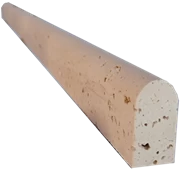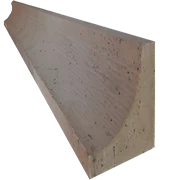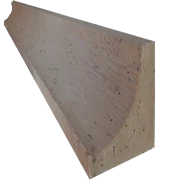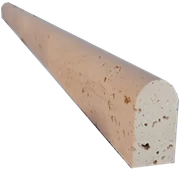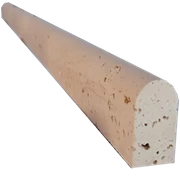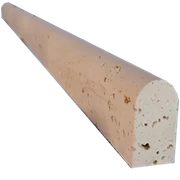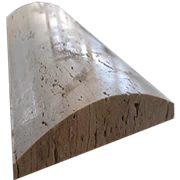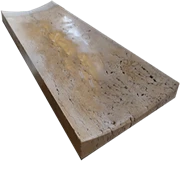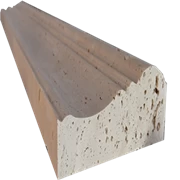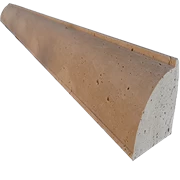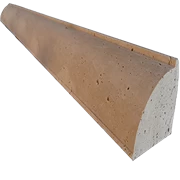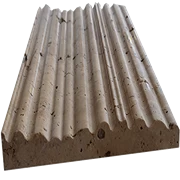stone edge profiles
Stone edge profiles are the shapes or contours applied to the edges of stone slabs, such as granite, marble, or quartz, commonly used in countertops, tabletops, and other surfaces.
These profiles not only enhance the aesthetic appeal of the stone but also influence its functionality and safety.
Here’s an overview of some common stone edge profiles:
1. Straight Edge (Eased Edge)
A straight edge, also known as an eased edge, features a simple, flat face with slightly rounded corners. This profile is popular for its clean, modern look and minimalistic appea
2. Beveled Edge
A beveled edge has a flattened corner at a specific angle, typically 45 degrees. This profile adds a touch of sophistication and can be varied by adjusting the width of the bevel.
3. Bullnose Edge
A bullnose edge is fully rounded, creating a smooth, semi-circular finish. This profile is ideal for a soft, classic look and is also practical, as it reduces the risk of chipping and injury.
4. Half Bullnose Edge
The half bullnose edge is rounded on the top with a flat bottom. It provides a softer look than a straight edge and allows liquids to flow off the surface without damaging the cabinetry below.
5. Ogee Edge
An ogee edge features an S-shaped curve, combining a concave arch with a convex arch. This ornate profile is often used in traditional or luxurious settings, adding intricate detail to the stone surface.
6. Dupont Edge
A Dupont edge, also known as a cove edge, starts with a straight drop followed by a curve. This profile gives a dramatic and elegant look, often used in high-end kitchen and bathroom designs.
7. Mitered Edge
A mitered edge involves two pieces of stone cut at a 45-degree angle and joined to create a seamless appearance. This profile is often used to create the illusion of a thicker slab and is popular in contemporary designs.
8. Waterfall Edge
A waterfall edge continues the stone pattern vertically down the sides of the countertop, creating a continuous flow. This profile exudes modernity and is often used in upscale kitchens and islands.
9.Chiseled Edge
A chiseled edge, also known as a rough or natural edge, mimics the raw, unpolished look of natural stone. This profile is perfect for rustic or outdoor settings, adding a touch of authenticity.
Choosing the right stone edge profile depends on the desired aesthetic, functionality, and overall design of the space. Each profile offers unique characteristics that can complement various styles, from contemporary to traditional. When selecting an edge profile, consider factors such as maintenance, safety, and the overall harmony with other design elements.
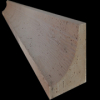
Stone edge profiles can indeed be made from natural stone, as well as from engineered or synthetic stone materials.
Here’s a more detailed look at the types of stone and the applications where these edge profiles are commonly used:
Types of Stone
1. Natural Stone
- Granite:Durable and resistant to scratches and heat, granite is a popular choice for kitchen countertops and bathroom vanities.
- Marble:Known for its elegance and unique veining, marble is often used in high-end kitchens, bathrooms, and decorative surfaces.
- Limestone: Softer than granite and marble, limestone offers a more matte and rustic look, suitable for indoor and outdoor applications.
- Travertine:Similar to limestone, travertine has a distinctive porous texture and is used in tiles, countertops, and flooring.
- Slate:With its fine-grained texture and natural cleft surface, slate is used for countertops, flooring, and roofing.
2. Engineered Stone
- Quartz: Made from a blend of natural quartz and resin, quartz countertops are non-porous, durable, and available in a wide range of colors and patterns.
- Porcelain: Engineered to mimic the look of natural stone, porcelain slabs are highly resistant to stains, heat, and scratches.
Applications
Stone edge profiles can be found in various residential and commercial settings, adding both aesthetic and functional value to the spaces.
Here are some common applications:
1. Kitchen Countertops
- Islands:Stone edge profiles on kitchen islands can become a focal point, adding elegance and style.
- Perimeter Countertops: Different edge profiles can complement or contrast with the island, creating a cohesive design.
2. Bathroom Vanities
- Sink Surrounds:Adding a decorative edge profile around bathroom sinks enhances the overall look and feel of the space.
- Shower Thresholds: Stone edges can be used to define and accentuate the thresholds of shower areas.
3. Tabletops
- Dining Tables:Stone tabletops with custom edge profiles can become statement pieces in dining rooms.
- Coffee and End Tables: Smaller tables can also benefit from detailed edge profiles, adding a touch of sophistication.
4. Fireplace Surrounds
- Mantels:Stone mantels with decorative edge profiles can enhance the beauty of a fireplace.
- Hearths:The edges of the hearth can be profiled to match or complement the mantel.
5. Outdoor Applications
- Patios:Stone edges on outdoor kitchen countertops or bar tops can withstand the elements while adding a stylish touch.
- Pool Coping: Natural stone with chiseled or bullnose edges is often used for pool coping, providing a smooth and safe edge.
6. Commercial Spaces
- Reception Desks:Custom stone edge profiles on reception desks can create a professional and welcoming first impression.
- Conference Tables: High-end conference tables with stone surfaces and unique edge profiles add a touch of luxury to corporate settings.
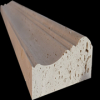
Stone edge profiles are versatile and can be applied to various natural and engineered stone materials. They enhance the aesthetic appeal and functionality of countertops, tabletops, vanities, and more, making them a popular choice in both residential and commercial designs. Selecting the appropriate edge profile can significantly impact the overall look and feel of the space, ensuring it meets both practical and decorative needs.
The maintenance and care requirements for granite, quartz, and marble edge profiles can vary quite a bit:
Granite:
- Granite is highly durable and resistant to scratches, chips, and stains.
- It requires minimal maintenance - simply wiping up spills and cleaning with a mild detergent and water.
- Granite edge profiles may need to be resealed every 1-2 years to maintain their water-resistance.
Quartz:
- Quartz is extremely durable and non-porous, making it very low-maintenance.
- It does not require sealing and is highly resistant to stains, scratches, and heat.
- Quartz edge profiles can simply be wiped clean with a damp cloth and mild soap.
Marble:
- Marble is a softer, more porous natural stone that requires more specialized care.
- Marble edge profiles are susceptible to etching and staining from acidic substances like lemon juice or wine.
- Marble must be sealed regularly (every 6-12 months) to protect the surface.
- Cleaning marble requires a pH-neutral, stone-safe cleaner to avoid damaging the material.
In general, quartz edge profiles require the least maintenance, followed by granite. Marble demands the most diligent care and attention to preserve its elegant appearance over time.
The specific maintenance needs should be considered when selecting the right stone edge profile material for a particular application or project.
A straight edge, also known as an eased edge, features a simple, flat face with slightly rounded corners. This profile is popular for its clean, modern look and minimalistic appea
2. Beveled Edge
A beveled edge has a flattened corner at a specific angle, typically 45 degrees. This profile adds a touch of sophistication and can be varied by adjusting the width of the bevel.
A bullnose edge is fully rounded, creating a smooth, semi-circular finish. This profile is ideal for a soft, classic look and is also practical, as it reduces the risk of chipping and injury.
The half bullnose edge is rounded on the top with a flat bottom. It provides a softer look than a straight edge and allows liquids to flow off the surface without damaging the cabinetry below.
An ogee edge features an S-shaped curve, combining a concave arch with a convex arch. This ornate profile is often used in traditional or luxurious settings, adding intricate detail to the stone surface.
A Dupont edge, also known as a cove edge, starts with a straight drop followed by a curve. This profile gives a dramatic and elegant look, often used in high-end kitchen and bathroom designs.
A mitered edge involves two pieces of stone cut at a 45-degree angle and joined to create a seamless appearance. This profile is often used to create the illusion of a thicker slab and is popular in contemporary designs.
A waterfall edge continues the stone pattern vertically down the sides of the countertop, creating a continuous flow. This profile exudes modernity and is often used in upscale kitchens and islands.
A chiseled edge, also known as a rough or natural edge, mimics the raw, unpolished look of natural stone. This profile is perfect for rustic or outdoor settings, adding a touch of authenticity.

Stone edge profiles can indeed be made from natural stone, as well as from engineered or synthetic stone materials.
- Granite:Durable and resistant to scratches and heat, granite is a popular choice for kitchen countertops and bathroom vanities.
- Marble:Known for its elegance and unique veining, marble is often used in high-end kitchens, bathrooms, and decorative surfaces.
- Limestone: Softer than granite and marble, limestone offers a more matte and rustic look, suitable for indoor and outdoor applications.
- Travertine:Similar to limestone, travertine has a distinctive porous texture and is used in tiles, countertops, and flooring.
- Slate:With its fine-grained texture and natural cleft surface, slate is used for countertops, flooring, and roofing.
- Quartz: Made from a blend of natural quartz and resin, quartz countertops are non-porous, durable, and available in a wide range of colors and patterns.
- Porcelain: Engineered to mimic the look of natural stone, porcelain slabs are highly resistant to stains, heat, and scratches.
Stone edge profiles can be found in various residential and commercial settings, adding both aesthetic and functional value to the spaces.
- Islands:Stone edge profiles on kitchen islands can become a focal point, adding elegance and style.
- Perimeter Countertops: Different edge profiles can complement or contrast with the island, creating a cohesive design.
- Sink Surrounds:Adding a decorative edge profile around bathroom sinks enhances the overall look and feel of the space.
- Shower Thresholds: Stone edges can be used to define and accentuate the thresholds of shower areas.
- Dining Tables:Stone tabletops with custom edge profiles can become statement pieces in dining rooms.
- Coffee and End Tables: Smaller tables can also benefit from detailed edge profiles, adding a touch of sophistication.
- Mantels:Stone mantels with decorative edge profiles can enhance the beauty of a fireplace.
- Hearths:The edges of the hearth can be profiled to match or complement the mantel.
- Patios:Stone edges on outdoor kitchen countertops or bar tops can withstand the elements while adding a stylish touch.
- Pool Coping: Natural stone with chiseled or bullnose edges is often used for pool coping, providing a smooth and safe edge.
- Reception Desks:Custom stone edge profiles on reception desks can create a professional and welcoming first impression.
- Conference Tables: High-end conference tables with stone surfaces and unique edge profiles add a touch of luxury to corporate settings.

Stone edge profiles are versatile and can be applied to various natural and engineered stone materials. They enhance the aesthetic appeal and functionality of countertops, tabletops, vanities, and more, making them a popular choice in both residential and commercial designs. Selecting the appropriate edge profile can significantly impact the overall look and feel of the space, ensuring it meets both practical and decorative needs.
- Granite is highly durable and resistant to scratches, chips, and stains.
- It requires minimal maintenance - simply wiping up spills and cleaning with a mild detergent and water.
- Granite edge profiles may need to be resealed every 1-2 years to maintain their water-resistance.
- Quartz is extremely durable and non-porous, making it very low-maintenance.
- It does not require sealing and is highly resistant to stains, scratches, and heat.
- Quartz edge profiles can simply be wiped clean with a damp cloth and mild soap.
- Marble is a softer, more porous natural stone that requires more specialized care.
- Marble edge profiles are susceptible to etching and staining from acidic substances like lemon juice or wine.
- Marble must be sealed regularly (every 6-12 months) to protect the surface.
- Cleaning marble requires a pH-neutral, stone-safe cleaner to avoid damaging the material.
FAQs
What types of stone edge profiles does stone edge profiles offer?
stone edge profiles offers a wide range of edge profile styles including bullnose, chamfered, pencil round, double pencil round, and flat edge profiles.
What stone materials are available from stone edge profiles?
stone edge profiles provides edge profiles made from natural stones like granite, marble, and quartz, as well as engineered stone materials.
How does the maintenance differ between granite, quartz, and marble edge profiles?
Granite requires minimal maintenance and periodic sealing, quartz is extremely low-maintenance, while marble demands more specialized care to prevent staining and etching.
Does stone edge profiles offer custom edge profile options?
Yes, stone edge profiles can provide custom profile designs and sizes to meet the specific needs of each project.
 +7929688-88-14
+7929688-88-14

 English
English
 Persian
Persian
 Russian
Russian
 Chinese
Chinese


 +7929688-88-14
+7929688-88-14

